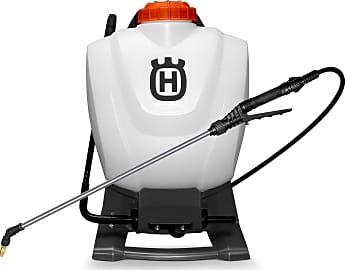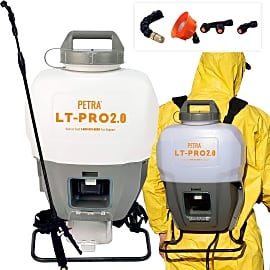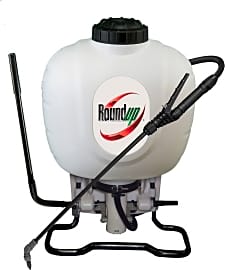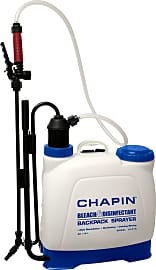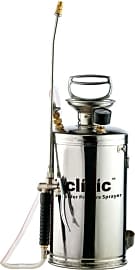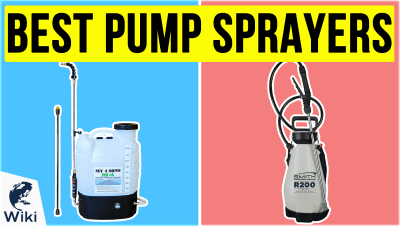The 10 Best Backpack Sprayers

This wiki has been updated 33 times since it was first published in February of 2017. Weeds and bugs are no match for these backpack sprayers, which provide a convenient, efficient method for treating your flower bed, garden or lawn without having to lug around buckets of chemicals. Just fill one of these up with your favorite fertilizer, pesticide, or herbicide, then strap it on and get to work. And always remember to wear the appropriate safety equipment. When users buy our independently chosen editorial picks, we may earn commissions to help fund the Wiki.
Editor's Notes
December 01, 2020:
We needed to eliminate several items from the list for a variety of reasons. The Tabor Tools Lawn is simply poorly constructed, suffering from a flimsy pump handle and an inability to hold pressure consistently. Even at its super low price, this item offers minimal value. Though the sprayer itself offers decent performance, the Solo 425 Pro features low-quality straps that don’t provide comfort or security. The My 4 Sons Wide now only includes the wand attachment, not the full backpack sprayer, and the Jacto PJB-16 has too many leaking issues to retain on the list.
Noted that the hose on the Clicic Stainless Steel may kink as times. We also highlighted that the Smith Performance R200 includes a high-foaming nozzle, a wide flat fan nozzle, a narrow flat fan nozzle, and an adjustable brass nozzle.
We added four new items to the list: two battery-powered options and two manual sprayers. Both automatic models offer impressive battery life; the Petra Professional can spray more than 50 gallons of solution on a single charge. The My 4 Sons M41000 is the most well-rounded of the new additions, with a wide assortment of nozzles, two wands (one steel, one plastic), and detailed measurement markings to help you identify exactly how much liquid is in the tank.
April 27, 2019:
Depending on what you're spraying, there are a few different varieties of backpack sprayer worth considering. For smaller jobs, the Smith R200 and Tabor Tools may be all you need. The former is pretty costly but very effective, while the latter is a budget-friendly model that may not stand up to full-time use. The Chapin Pro and the Solo are high-capacity options that can get you through an entire lawn's worth of fertilizing, though the D.B. Smith Field King is a touch less expensive and slightly more well-made. Chapin also makes a unit with enhanced chemical resistance; it's designed for use with more corrosive fluids, though it can't stand up to the most dangerous substances. If you'll be using something that isn't friendly with plastic, Clicic makes a stainless-steel model that should do the trick.
If you want to avoid pumping at all costs, check out the My 4 Sons or the Jacto, whose battery power will prevent you from having to pressurize anything by hand. They're designed for use with a wide range of chemicals. If you're focused mostly on reducing the numbers of disease-carrying and itch-inducing pests like mosquitoes and ticks, the Cardinal may be a good bet. It is both expensive and heavy, but for large areas including golf courses, parks, and huge yards, its exceptional range and 2-in-1 blower functionality make it hard to beat.
No matter which one you choose and what chemicals you're using, be absolutely certain to use the proper personal protective equipment. As long as you follow the directions carefully, most chemical sprays are safe, but even a tiny slip-up can lead to exposure to a potentially hazardous chemical. And remember that a simple dust mask is not usually sufficient to keep chemicals out of your body; a filtered breather, glasses or goggles, long pants and long-sleeve shirts, and chemical-resistant gloves are basically all necessities when working with concentrated chemicals, especially when you're spraying them in a fine mist. That includes pesticides, fertilizers, paints or other finishing chemicals, you name it. Do everything in your power to avoid breathing anything but uncontaminated air.
Special Honors
Stihl Sprayers Stihl has something for everyone, with sprayers in a vast range of sizes at different price points. The compact options are lightweight and ideal for accuracy and control, whereas the larger, more powerful options feature two-stroke engines that help deliver extensive coverage. stihlusa.com
Milwaukee Switch Tank Built for professional applications, the Switch Tank has a useful pressure adjustment knob with five settings for achieving various spray distances. The soft, wide straps are easy on the shoulders during a long work day, and the motorized pump allows you to maintain consistent pressure up to 120 PSI. milwaukeetool.com
Attributes And Applications Of A Quality Sprayer
Heck, it even works well as a means to apply cleaning solution to your car or within your workplace.
Technically, a backpack sprayer can be used to disperse any liquid for any reason. If you feel the urge to load it up with milk and spray down your front door with it, no one’s stopping you; just be prepared to receive some odd looks from your neighbors (and a few ants).
If I had to guess, most of you are looking into buying a backpack sprayer for gardening and lawn maintenance purposes. If so, you came to the right place, as these models are ideal for just that. Essentially pump sprayers that are simply worn on your back, these handy landscaping tools offer excellent versatility while they help reduce arm fatigue that may come with carrying a standard sprayer.
Most gardeners, whether they’re hobbyists or employed by a nursery or greenhouse, use a backpack sprayer to distribute water or chemicals like fertilizers, pesticides, herbicides, and fungicides. Because of this, its uses vary from watering an infant sapling to ridding your lawn of pests and weeds. Heck, it even works well as a means to apply cleaning solution to your car or within your workplace.
If you decide to switch between different chemicals, remember to use a neutralizer to thoroughly clean the sprayer between each use for effective application and performance. If you’ll be using separate chemicals often, it may be worth it to invest in one sprayer for each chemical type.
These backpack versions come with a wrap-around wand that dispenses the liquid. You’ll want to examine how long the reach of the hose is, whether or not it has multiple nozzles, and the level of pressure with which it sprays. Think about the pump, as well. It can be a pain to remove the tank in order to pump, so you may want to consider a model that features a lever pump along the side. This allows you to maintain the pressure and achieve a more uniform output than that of a hand-held sprayer.
In addition, the amount of ground you’re going to cover will impact the type of sprayer you choose. Will you be watering and treating plants across multiple acres of land? If so, make sure the reservoir of your device has a large enough capacity. Will you use it every day? If it must endure continuous use, you’ll probably want a model with a durable metal nozzle that will resist wear and tear over a long period of time.
What You Should Know About The Chemicals You Apply
When you work with potentially hazardous chemicals in any capacity, you should always exercise appropriate caution. This includes educating yourself to a certain degree about the liquids in question. Before you spray, ensure that you’re wearing protective gear, such as eyewear and gloves.
This includes educating yourself to a certain degree about the liquids in question.
Pesticide application can actually be quite complicated. There’s plenty to consider when using these chemicals to rid yourself of unwanted pests: potential effects on your health, ways they might impact the environment, and methods for maximizing the efficiency of your spray. Of course, these issues are of greater concern for more commercial agricultural applications, but that doesn’t mean you should overlook them, as they also pertain to your use on a smaller scale.
More than 90 percent of insecticides and herbicides eventually land on a destination other than their intended target. This can include pets, other humans, and a variety of objects you come into contact with daily. As some of these solutions can cause serious health problems, make sure to be extremely careful when applying them.
As a gardener, fertilizer can be a godsend. It boosts the growth of your plants by enhancing the soil and providing valuable nutrients. While most fertilizers are applied as solids, in this case, you apply it as a liquid. Using a liquid form provides better coverage and dramatically speeds up a fertilizer's effect. The process for storage and handling of fertilizer can be quite meticulous; make sure to familiarize yourself with the recommended approach. You should also exercise caution when using fertilizers, as they’re capable of having harmful effects on the environment, as well.
Treat Your Garden Right — It Will Reciprocate
Now that you’ve considered the sprayer's features and liquid contents, let’s focus on the task at hand: growing the most beautiful, lush garden you possibly can. When it comes to spraying, some things come down to common sense, such as applying pesticides when insects are present and herbicides when weeds are overgrown. In other cases, a little more strategy is involved.
If you’re worried about the adverse effects of the chemical solutions you’re using, you can always try using a more organic option.
In early spring, you can take preventative measures, such as spraying dormant pesticide before insects invade or applying herbicide to prevent weeds from developing in the first place. Once summer arrives, you can develop a regular spray program. Monitor your crop for plant disease along the way, removing dead plants and weeds as you discover them. As the summer wears on, make sure to spray insect breeding grounds to attack them at the source, paying particular attention to mosquitoes. In the fall, it’s wise to spray the perimeter of your house as bugs seek a warm hiding place.
If you’re worried about the adverse effects of the chemical solutions you’re using, you can always try using a more organic option. For example, simple vinegar can be used as a weed killer. For fertilizer, you can mix water with grass clippings, seaweed, and dried manure as a free liquid option. Plus, you can always investigate the ingredients of the particular solution you wish to use ahead of time, which will allow you to choose a brand with which you’re comfortable.
Once you’ve obtained your solutions, loaded up the tank, and finished the spraying process, you can sit back and admire the results. This should come as no surprise to you green thumbs out there, but research indicates that gardening is good for your health. And let’s be honest, there’s just something special about knowing that your own garden produced every single ingredient in the salad you're eating for dinner.





